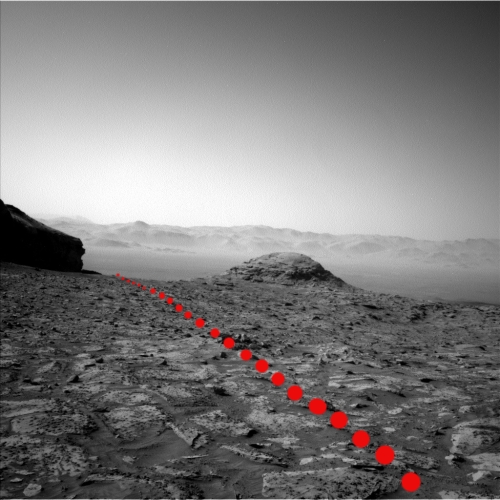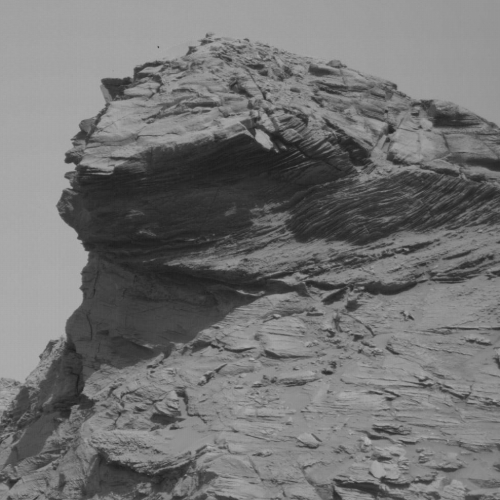Curiosity: Through the notch and looking back
The Mars rover Curiosity has now climbed up into Maria Gordon Notch. The image to the right, reduced to post here, was taken by the rover’s left navigation camera and looks back at the entrance to the notch, with the floor and rim of Gale Crater beyond. The crater floor is about 1,700 feet below and the rim is about 30 miles away.
The red dotted line indicates the path Curiosity took after entering the notch, traveling about 80 feet to the southeast. The rover will continue south inside the notch for another 800 feet or so and then turn west, climbing out of the notch and up onto the Greenheugh Pediment and continuing west until it gets to the base of Gediz Vallis Ridge, a ridge that had been in prominent view about a year ago when the rover was north of it but lower down the mountain. (See the panorama in this February 2021 post.)
Below is another picture from a day earlier, this time taken by the rover’s high resolution mast camera. I think it looks up at the top of the western cliff, but now looks at that cliff after having gone past it slightly.
The number of layers is amazing. More amazing however is the overhang, since it is also made of these many thin layers and thus cannot be very structurally strong. Yet the top of the cliff leans outward, with the layers actually tilted a considerable distance, with some appearing to even be slightly separated from the main body of the cliff. And yet they don’t fall.
The lighter Mars’ gravity, about 39% of Earth’s, explains this, but nonetheless the view is strange and alien. I can’t imagine such thin layers holding together and tilting outward like this on Earth. The top layers would certainly break off, especially the sections on the outermost overhang.
On Christmas Eve 1968 three Americans became the first humans to visit another world. What they did to celebrate was unexpected and profound, and will be remembered throughout all human history. Genesis: the Story of Apollo 8, Robert Zimmerman's classic history of humanity's first journey to another world, tells that story, and it is now available as both an ebook and an audiobook, both with a foreword by Valerie Anders and a new introduction by Robert Zimmerman.
The print edition can be purchased at Amazon or from any other book seller. If you want an autographed copy the price is $60 for the hardback and $45 for the paperback, plus $8 shipping for each. Go here for purchasing details. The ebook is available everywhere for $5.99 (before discount) at amazon, or direct from my ebook publisher, ebookit. If you buy it from ebookit you don't support the big tech companies and the author gets a bigger cut much sooner.
The audiobook is also available at all these vendors, and is also free with a 30-day trial membership to Audible.
"Not simply about one mission, [Genesis] is also the history of America's quest for the moon... Zimmerman has done a masterful job of tying disparate events together into a solid account of one of America's greatest human triumphs."--San Antonio Express-News
The Mars rover Curiosity has now climbed up into Maria Gordon Notch. The image to the right, reduced to post here, was taken by the rover’s left navigation camera and looks back at the entrance to the notch, with the floor and rim of Gale Crater beyond. The crater floor is about 1,700 feet below and the rim is about 30 miles away.
The red dotted line indicates the path Curiosity took after entering the notch, traveling about 80 feet to the southeast. The rover will continue south inside the notch for another 800 feet or so and then turn west, climbing out of the notch and up onto the Greenheugh Pediment and continuing west until it gets to the base of Gediz Vallis Ridge, a ridge that had been in prominent view about a year ago when the rover was north of it but lower down the mountain. (See the panorama in this February 2021 post.)
Below is another picture from a day earlier, this time taken by the rover’s high resolution mast camera. I think it looks up at the top of the western cliff, but now looks at that cliff after having gone past it slightly.
The number of layers is amazing. More amazing however is the overhang, since it is also made of these many thin layers and thus cannot be very structurally strong. Yet the top of the cliff leans outward, with the layers actually tilted a considerable distance, with some appearing to even be slightly separated from the main body of the cliff. And yet they don’t fall.
The lighter Mars’ gravity, about 39% of Earth’s, explains this, but nonetheless the view is strange and alien. I can’t imagine such thin layers holding together and tilting outward like this on Earth. The top layers would certainly break off, especially the sections on the outermost overhang.
On Christmas Eve 1968 three Americans became the first humans to visit another world. What they did to celebrate was unexpected and profound, and will be remembered throughout all human history. Genesis: the Story of Apollo 8, Robert Zimmerman's classic history of humanity's first journey to another world, tells that story, and it is now available as both an ebook and an audiobook, both with a foreword by Valerie Anders and a new introduction by Robert Zimmerman.
The print edition can be purchased at Amazon or from any other book seller. If you want an autographed copy the price is $60 for the hardback and $45 for the paperback, plus $8 shipping for each. Go here for purchasing details. The ebook is available everywhere for $5.99 (before discount) at amazon, or direct from my ebook publisher, ebookit. If you buy it from ebookit you don't support the big tech companies and the author gets a bigger cut much sooner.
The audiobook is also available at all these vendors, and is also free with a 30-day trial membership to Audible.
"Not simply about one mission, [Genesis] is also the history of America's quest for the moon... Zimmerman has done a masterful job of tying disparate events together into a solid account of one of America's greatest human triumphs."--San Antonio Express-News




Strange New Worlds!
Indeed !!!
Looking forward to the Next….
Thousand Pics !!!
I’m not sure that layering necessarily implies weakness – those could be tenacious, strongly bonded layers.
Icepilot: You could be right, but I base my expectation on weakness based on previous evidence in other places such as the failed attempt by InSight’s mole to drill down because the soil was weak. The low Martian gravity appears to result in generally less dense material near the surface.
In addition, these layers are part of the Greenheugh Pediment, which is a very broken layer sitting on top of other more structural sound layers. Take a look at the panorama at the top of this March 2020 rover update. It looks out across the Pediment, a broken landscape of disconnected paving stones.
“To explore strange, new worlds”
Wow.
That overhang is coming down, though. Although a little more slowly in MarsG.